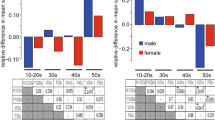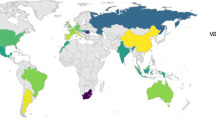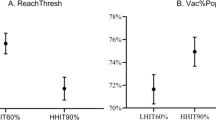Abstract
Most vaccines protect both the vaccinated individual and the community at large by building up herd immunity. Even though reaching disease-specific herd immunity thresholds is crucial for eliminating or eradicating certain diseases1,2, explanation of this concept remains rare in vaccine advocacy3. An awareness of this social benefit makes vaccination not only an individual but also a social decision. Although knowledge of herd immunity can induce prosocial vaccination in order to protect others, it can also invite free-riding, in which individuals profit from the protection provided by a well-vaccinated society without contributing to herd immunity themselves. This cross-cultural experiment assesses whether people will be more or less likely to be vaccinated when they know more about herd immunity. Results show that in cultures that focus on collective benefits, vaccination willingness is generally higher. Communicating the concept of herd immunity improved willingness to vaccinate, especially in cultures lacking this prosocial cultural background. Prosocial nudges can thus help to close these immunity gaps.
This is a preview of subscription content, access via your institution
Access options
Access Nature and 54 other Nature Portfolio journals
Get Nature+, our best-value online-access subscription
$29.99 / 30 days
cancel any time
Subscribe to this journal
Receive 12 digital issues and online access to articles
$119.00 per year
only $9.92 per issue
Buy this article
- Purchase on Springer Link
- Instant access to full article PDF
Prices may be subject to local taxes which are calculated during checkout




Similar content being viewed by others
References
Fine, P., Eames, K. & Heymann, D. L. ‘Herd immunity’: a rough guide. Clin. Infect. Dis. 52, 911–916 (2011).
Anderson, R. M. & May, R. M. Vaccination and herd immunity to infectious diseases. Nature 318, 323–329 (1985).
Shim, E., Chapman, G. B., Townsend, J. P. & Galvani, A. P. The influence of altruism on influenza vaccination decisions. J. R. Soc. Interface 9, 2234–2243 (2012).
Herd immunity. The History of Vaccineshttp://www.historyofvaccines.org/content/herd-immunity-0 (2016).
Parents’ Guide to Childhood Immunizations (Centers for Disease Control and Prevention, 2015); http://www.cdc.gov/vaccines/pubs/parents-guide
Bauch, C. T., Galvani, A. P. & Earn, D. J. D. Group interest versus self-interest in smallpox vaccination policy. Proc. Natl Acad. Sci. USA 100, 10564–10567 (2003).
Vietri, J. T., Li, M., Galvani, A. P. & Chapman, G. B. Vaccinating to help ourselves and others. Med. Decis. Mak. 32, 447–458 (2012).
Böhm, R., Betsch, C. & Korn, L. Selfish-rational non-vaccination: experimental evidence from an interactive vaccination game. J. Econ. Behav. Organ. 131, 183–195 (2016).
Betsch, C., Böhm, R. & Chapman, G. B. Using behavioral insights to increase vaccination policy effectiveness. Policy Insights Behav. Brain Sci. 2, 61–73 (2015).
Fischoff, B., Brewer, N. T. & Downs, J. Communicating Risks and Benefits: An Evidence-Based User’s Guide (FDA, 2011); http://www.fda.gov/ScienceResearch/SpecialTopics/RiskCommunication/default.htm
Au, W. T. & Kwong, J. Y. Y. in Contemporary Psychological Research on Social Dilemmas (eds Suleiman, R., Budescu, D., Fischer, I. & Messick, D. ) 71–98 (Cambridge Univ. Press, 2004).
Murphy, R. O. & Ackermann, K. A. Social value orientation: theoretical and measurement issues in the study of social preferences. Pers. Soc. Psychol. Rev. 18, 13–41 (2014).
McClintock, C. G. & Allison, S. T. Social value orientation and helping behavior. J. Appl. Soc. Psychol. 19, 353–362 (1989).
Hofstede, G. Culture’s Consequences: Comparing Values, Behaviors, Institutions and Organizations across Nations (Sage, 2001).
Triandis, H. C. & Gelfand, M. J. Converging measurement of horizontal and vertical individualism and collectivism. J. Pers. Soc. Psychol. 74, 118–128 (1998).
Oyserman, D., Coon, H. M. & Kemmelmeier, M. Rethinking individualism and collectivism: evaluation of theoretical assumptions and meta-analyses. Psychol. Bull. 128, 3–72 (2002).
Markus, H. R. & Kitayama, S. Culture and the self: implications for cognition, emotion, and motivation. Psychol. Rev. 98, 224–253 (1991).
Thomson, A. & Watson, M. Listen, understand, engage. Sci. Transl. Med. 4, 138ed6 (2012).
Reyna, V. F. Risk perception and communication in vaccination decisions: a fuzzy-trace theory approach. Vaccine 30, 3790–7 (2012).
Hofstede, G. H. Cultural Dimensions (2016); https://geert-hofstede.com/cultural-dimensions.html
Aiken, L. S., West, S. G. & Reno, R. R. Multiple Regression: Testing and Interpreting Interactions (Sage, 1991).
Gross National Income per Capita 2015, Atlas Method and PPP (World Bank, 2015); http://databank.worldbank.org/data/download/GNIPC.pdf
Tuberculosis Case Detection Rate (%, All Forms) (World Bank, 2016); http://data.worldbank.org/indicator/SH.TBS.DTEC.ZS
State of Vaccine Confidence 2016: global Insights through a 67-Country Survey. The Vaccine Confidence Projecthttp://www.vaccineconfidence.org/we-are-pleased-to-announce-the-publication-ofthe-state-of-vaccine-confidence-2016/ (2016).
Hayes, A. F. Introduction to Mediation, Moderation, and Conditional Process Analysis 3–4 (Guilford, 2013).
Chen, R. T. Vaccine risks: real, perceived and unknown. Vaccine 17, S41–S46 (1999).
Roush, S. W. & Murphy, T. V. Historical comparisons of morbidity and mortality for vaccine-preventable diseases in the United States. J. Am. Med. Assoc. 298, 2155–2163 (2007).
Omer, S. B., Salmon, D. A., Orenstein, W. A., DeHart, M. P. & Halsey, N. Vaccine refusal, mandatory immunization, and the risks of vaccine-preventable diseases. N. Engl. J. Med. 360, 1981–1988 (2009).
Deterding, S., Dixon, D., Khaled, R. & Nacke, L. From game design elements to gamefulness. In Proc. 15th Int. Academic MindTrek Conf. Envisioning Future Media Environments 9–15 (ACM, 2011).
Deterding, S. Gamification: designing for motivation. Interactions 19, 14–17 (2012).
Gorodnichenko, Y. & Roland, G. in Institutions and Comparative Economic Development (eds Aoki, M., Kuran, T. & Roland, G. ) 213–236 (Palgrave Macmillan, 2012); http://dx.doi.org/10.1057/9781137034014_12
Talhelm, T. et al. Large-scale psychological differences within China explained by rice versus wheat agriculture. Science 344, 603–608 (2014).
Betsch, C. et al. Improving medical decision making and health promotion through culture-sensitive health communication: an agenda for science and practice. Med. Decis. Making 36, 811–833 (2016).
Sheeran, P. Intention–behavior relations: a conceptual and empirical review. Eur. Rev. Soc. Psychol. 12, 1–36 (2002).
Lehmann, B. A., Ruiter, R. A. C., Chapman, G. & Kok, G. The intention to get vaccinated against influenza and actual vaccination uptake of Dutch healthcare personnel. Vaccine 32, 6986–6991 (2014).
Hofstede, G. H., Hofstede, G. J. & Minkov, M. Cultures and Organizations: Software of the Mind (McGraw-Hill, 2010).
Betsch, C., Böhm, R., Korn, L. & Holtmann, C. On the Benefits of Explaining Herd Immunity in Vaccine Advocacy (OSF, 2017); https://osf.io/9a7sb/
Acknowledgements
Funding from the Asia Pacific Alliance for the Control of Influenza (APACI) for C.B. and R.B., as well as from the Excellence Initiative (ZUK II) of the German Research Foundation (DFG) for R.B., is gratefully acknowledged. The funders had no role in study design, data collection and analysis, decision to publish, or preparation of the manuscript. We thank colleagues in the participating countries for support during data collection (W. J. Kim, S. Kim, M. Kim, M. C. van Egmond, D. Thi The, P. K.S. Chan, M. Khanna, K. Sampson and U. Kühnen), especially K. Sampson of APACI for continuous support during all stages of the study. We thank L. Jennings and F. Renkewitz for comments on earlier versions of this manuscript, and K. Eames for support with the epidemiological underpinnings.
Author information
Authors and Affiliations
Contributions
C.B. and R.B. designed the study, analysed the data and wrote the article. L.K. and C.H. assisted in this process and were responsible for data collection and data management.
Corresponding author
Ethics declarations
Competing interests
The authors declare no competing interests.
Supplementary information
Supplementary Information
Supplementary Figures 1–2, Supplementary Tables 1–8, Supplementary Note, Supplementary Methods, Supplementary References. (PDF 266 kb)
Rights and permissions
About this article
Cite this article
Betsch, C., Böhm, R., Korn, L. et al. On the benefits of explaining herd immunity in vaccine advocacy. Nat Hum Behav 1, 0056 (2017). https://doi.org/10.1038/s41562-017-0056
Received:
Accepted:
Published:
DOI: https://doi.org/10.1038/s41562-017-0056
This article is cited by
-
Policy makers believe money motivates more than it does
Scientific Reports (2024)
-
The Effect of Being Vaccinated and National Vaccination Rates on Individuals’ Cognitions, Emotions, and Economic Expectations: Evidence from Israel
International Journal of Behavioral Medicine (2024)
-
Wie gelingt eine soziallagenbezogene Impfprävention? Ein Beispiel der Coronaimpfkampagne des Landes Bremen
Prävention und Gesundheitsförderung (2024)
-
Transformative dimensions of resilience and brittleness during health systems’ collapse: a case study in Brazil using the Functional Resonance Analysis Method
BMC Health Services Research (2023)
-
Community dialogue meetings among district leaders improved their willingness to receive COVID-19 vaccines in Western Uganda, May 2021
BMC Public Health (2023)



